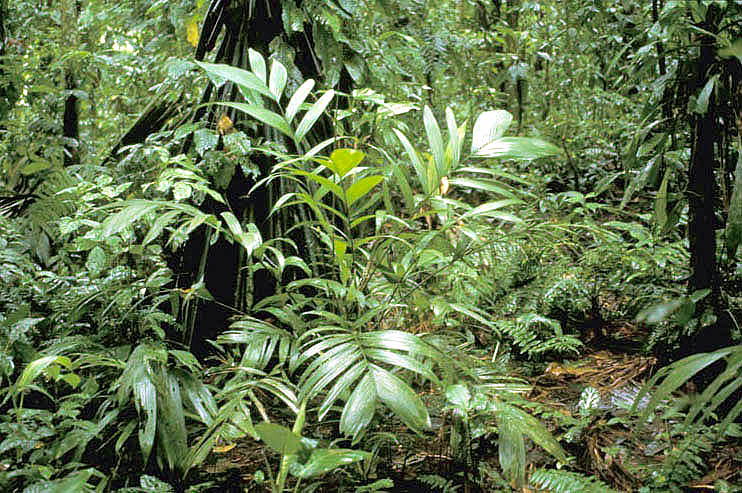Solitary palmtree; trunk smooth, bright gray, with red tinge from crustaceous lic.hens! 1730 cm long from base to inser-tion of lowermost leaf, diam. at brebst heigth 27 cm, diam below crown 17 cm; leafsc.ars 1-3 cm wide, conspicuous, internodal length widest centrally to 30 cm, leafscars nearly confluent below crown. One spear shaped juvenile leaf; num- ber of leaves 17, erect and graciously curving with pendent pinnae; leafsheath 145 cm long, the basalmost 5 – 10 cm encircling, splitting in fibrous mesh, covered by thick wax adaxially, inner surfare yellow to green distally; petiole 75 cm long, convex-concave basally to semiterete distally, 3 cm thick and 8 cm wide basally to 6 cm wide distally; rachis 335 cm, dorso-ventrally flattened basally, gradually nar- rowing and finally with an edge above conspicuous at 208 cm above the base, more or less twisted, green with white feltation below and above, glabrous laterally in spaces between pinnae; number of pinnae 2 X 102, regularly distri- buted, subalternate to opposite; longest pinna to 95 X 4.5 cm; lamina strongly pliated along midrib, dark green and shiny above, covered with white wax below. One infructes- cence and one old deflorated inflorescence. Inflorescence: peduncle 166 cm long, to 3 cm wide below lowermost rachilla, cross section oval prophyll 50 cm long, cream to dark brown apically, splitting to the base adaxially and app. 12 cm down on abaxial side, lst sheathing bract 75 cm long splitting laterally in the right side as viewed from adaxial side, cream to dark brown apically; 2nd sheathing bract 118 cm long, spitting in opposite side relative to previous sheathing bract, cream to dark. brown and partly desintegra- ted apically; 3rd sheathing bract 144 cm long and strongly desintegrated 4th sheathing bract 215 cm long and strongly desintegrated, 5th sheathing bract 223 ,cm long and strongly desintegrated; 6th bract 25 cm long, narrowly deltoid, 7th bract non- sheathing, 6 cm long, basally 3.5 cm wide, apically cuspida-te; rechis 112 cm, number of 1 st order lateral branches 66, apical rachillae 23, transition from lateral branches to apical rachillae gradual, lateral branches to 55 cm long, flattened, 1.5 cm wide basally, 2nd order lateral branches to 15 cm long; rachillae to 9 cm long, characteristically zig-zag’ed, each one bearing one or rarely two fruits Fruits globulor, green, to 1.8 cm in diam., surface verrucose, tissue adjacent to fruit petiole swelled. Common name: “Pumbo” Use: basal part of the peduncle of the young inflorescence edible. Preparationon: cooked ond mixed with rniscellaneous vegetables. Information: Jose Cape of Volledolid Duplicates: COL (5), QCA (5), MECN (5) A. BARFOD, B. BERGMAN and H. BORGTOFT PEDERSEN No. 60173
Latest posts by admin (see all)
- Aluminium Rattan Garden Furniture Design Ideas - September 11, 2019
- Popular Gardens and Parks in Sheffield, United Kingdom - September 18, 2018
- How New Eco-Friendly Garden Benches Help Plants and Consumers in the UK - February 26, 2018




Discussion: